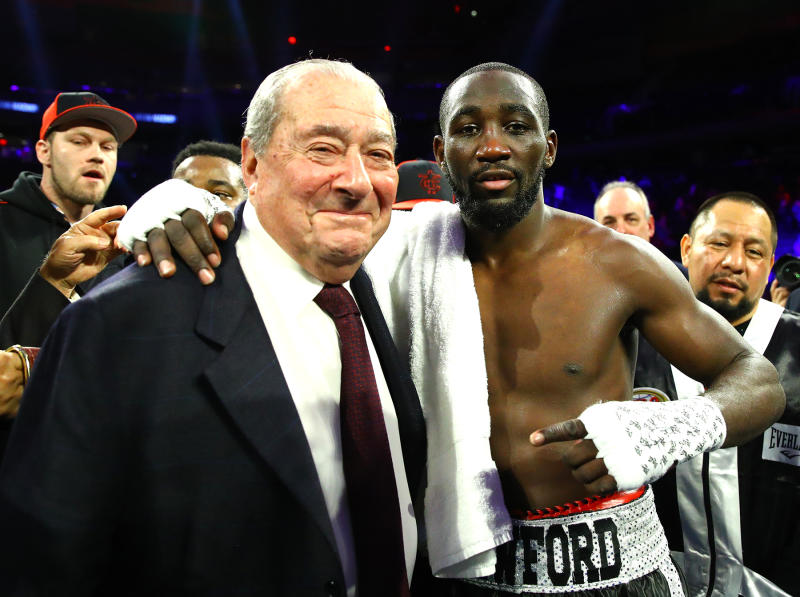 Re: Corona virus killing sports at the moment
Re: Corona virus killing sports at the moment
Coronavirus upends boxing's pay structure, meaning fighters must take less once pandemic ends
Why fighters must take less after coronavirus pandemic
In most professional sports, an athlete’s pay is directly related to performance. Nice guy or bad guy, popular or not, if you help your team win, you will be paid. The more helpful you are, the more you will be paid.
And, that’s as it should be despite some fans, particularly old-timers, shuddering at the Monopoly-type numbers being thrown around today. Adjusted for inflation, Babe Ruth only made $16.4 million — in his entire career. And Ruth’s $80,000 salary in 1931 would equate to $1.3 million in 2020, or about $35 million less than New York Yankees pitcher Gerrit Cole will make when this season begins.
The money is there, though, and so the players in all sports are worth what they can get. There are salary caps in the NBA, NFL and NHL, which dictate the pool from which the players are paid. The NBA players recently agreed to take 25 percent pay cuts beginning on May 15.
And when those cap leagues begin their next season, salaries are going to come down because revenues have declined.
Boxing, though, is different. Paying for performance is only part of the equation, and the less important part. The Yankees’ gross revenues won’t change appreciably no matter how Cole performs. Yankee Stadium is still going to be largely sold out, TV ratings will be high and the Yankees will basically have that license to print money.
Boxing is vastly different. If a fighter is great but can’t sell tickets, the promoter is going to be in dire straits if the pay structure of the contract is judged by performance like it is in MLB, NHL, NFL and NBA.
The majority of fighters who earn $1 million a fight wind up being losing propositions for promoters. And while few feel sorry for promoters, there are no fights without the promoters.
That’s why, coming off this coronavirus pandemic that has completely upended the business, fighters are going to have to take less than they’ve traditionally earned.
Among the problems boxing faces in in the U.S. is relatively tepid TV ratings, poor ticket sales and an almost non-existent pay-per-view market. When fights resume, they’ll be in closed venues with no audience, which is only going to increase problems for promoters, most of whom lose money on the vast majority of their shows.

Terence Crawford, the brilliant and unbeaten WBO welterweight champion, made a remarkable statement during a podcast interview with Chris Mannix of Sports Illustrated. Crawford said he’d need to make more money if he fought without fans.
“ ... If it was to happen, then they have to pay me more. You know, they have to pay me more because fighters of my status and on my level, we get paid for the people that’s coming there as well. So, you know, if I can’t get paid off of people coming, then I’m gonna have to get paid up front.”
The money simply isn’t there, and Crawford’s view, and the view of others similarly situated, is selfish. Where does he think this money is coming from? His words are ridiculously short-sighted and display an ignorance of the way the business works.
He sells tickets when he fights in Omaha, Nebraska, his hometown, but he’s not a draw anywhere else. And he’s a complete bomb when it comes to selling on PPV. He didn’t sell 100,000 pay-per-views for his fight last year against Amir Khan, when he was guaranteed $5 million plus a percentage of the PPV sales. He sold similarly poorly in his PPV bout with Viktor Postol.
The sport can make a comeback if it makes the fights the fans want to see on a regular basis, makes deep, evenly matched cards and spends time and money on advertising.
Fighters like Canelo Alvarez and Anthony Joshua are worth what they earn because they bring in tremendous amounts of money. But they are two of the few who do that.
And while no one is asking these fighters to be paid like paupers, there has to be some kind of an adjustment given the devastation that has been wrought on the sport. If Crawford, for instance, were to get a $3 million guarantee and a better deal on the upside, he’d have more incentive to help sell the show, which in turn would make the business better for everyone. It would also enable the promoters to spend more money on a deep and talented undercard with competitive fights.
When the NHL returned from its lockout in 2005, it made a number of adjustments to make the sport more fan-friendly. Boxers need to be a part of that, as well. Fighters used to making $5 million may have to accept $3 million, and those making $3 million may have to take $2 million instead. They’re hardly living like paupers at those figures, but the money is more reflective of their value.
https://uk.sports.yahoo.com/news/pan...192528689.html
Do not let success go to your head and do not let failure get to your heart.


 Thanks:
Thanks:  Likes:
Likes:  Dislikes:
Dislikes: 





 Reply With Quote
Reply With Quote
Bookmarks